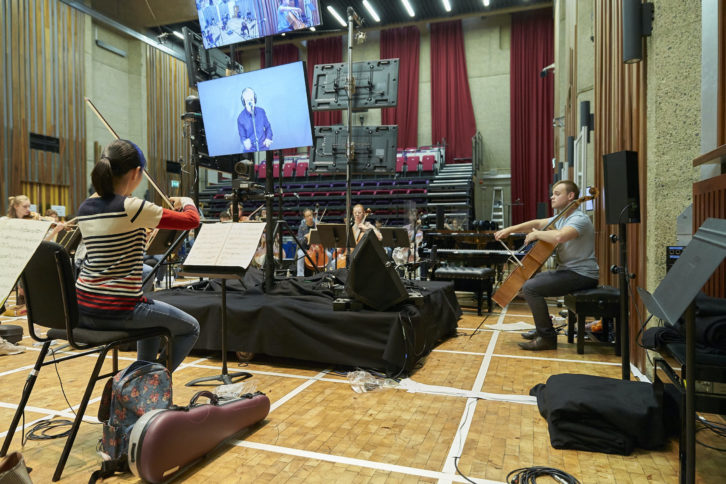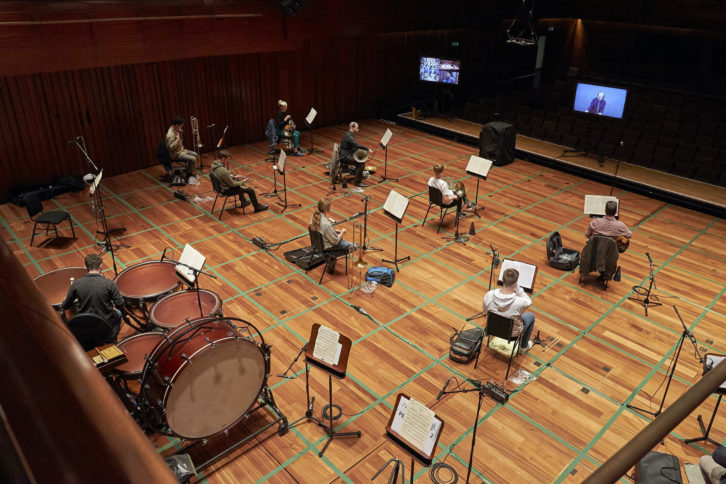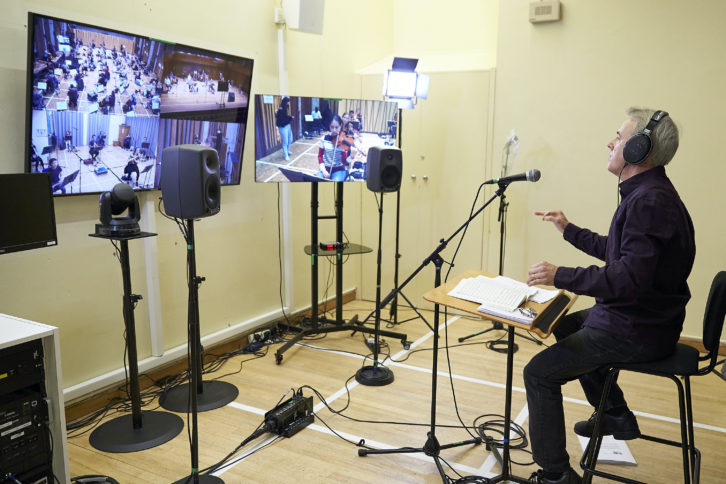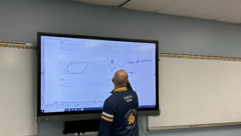
To adhere to social distancing requirements, performances at the Guildhall School of Music & Drama are constructed across four separate rooms and performed synchronously with one another using Dante .
Guildhall School of Music & Drama in London is one of the premiere arts colleges in the world. Among its notable alumni are actors Ewan McGregor and Daniel Craig, and musicians Jacqueline du Pré and Sir Bryn Terfel. Since its opening in 1880, the School has become one of the most prestigious conservatoires, ranked as one of the top ten performing arts institutions in the world according to QS World University Rankings 2020.
Key to the School’s musical curricula is its annual award for The Gold Medal – a performance competition that began in 1915 and had taken place uninterrupted through 2019. Of course, because of the global pandemic in 2020, the annual May performance had to be put on hold as teaching moved online during the summer term.
“Because of COVID we needed to be swift in our response to ensure things like The Gold Medal could occur and, very importantly, that in-person classes could still take place with full-scale participation,” said Julian Hepple, Head of Recording and Audio Visual at Guildhall School. “To make that happen we quickly turned to Dante and Dante Domain Manager. And, in September, as we returned to in-person teaching, we were able to hold The Gold Medal and broadcast the performance online.”
For Guildhall School, Dante enabled them to solve COVID-related challenges both with their analog acoustic live performances and their virtual learning environment.
Acoustic Meets Digital Over Dante
To adhere to social distancing requirements, The Gold Medal performances were constructed across four separate rooms. The largest space was populated by those on string instruments and the piano, with each participant located two meters apart. Woodwind and brass instruments were split up each into their own rooms, with three meters of space allocated between performers. Finally, the conductor was located in a fourth room. The challenge of this setup, of course, was collaboration among the multiple rooms.
“We had 90 musicians in total across the different rooms and building,” Hepple said. “We needed to manage a number of inputs and outputs across the space and have them be as latency-free as possible. They needed to be able to perform synchronously with one another.”
To do this, 40 Neumann, Rupert Neve Designs, Schoeps, and DBA directional microphones were strategically placed across the space to capture instrument audio. These feeds are brought into SSL, Yamaha and Neutrik preamplifiers where they’re translated into Dante-native channels. These Dante feeds then head to Cisco and Dell switch infrastructure across two buildings, and then routed to a Solid State Logic System T mixer that allows for broadcast specific processing. The audio feeds are then delivered out to two locations: to the broadcast mix for live playout via a live production system, and to the other performers via headphones.
“With Dante we were able to deliver the correct mix to the different rooms with an imperceptible level of latency,” Hepple said. “Our conductor went into rehearsals on day one, and within 20 bars he said he was ready to go. This is someone who has decades of experience in the classical performance space, and it was an immediate acceptance of the new setup.”
Despite the unique visual – the setup across four different rooms – the production is a seamless performance.
“There was a time when we were worried this could be cancelled,” Hepple said. “However, with Dante we were able to keep it alive. And that’s a big deal right now because our rooms, which are normally alive and vibrant, had been silent for six months. Bringing the music back was important for everyone.”
The setup was also used to present a Guildhall Symphony Orchestra concert conducted by Jessica Cottis, which was made available to watch online for one week from Saturday, Nov. 7.
Masterclasses With Dante
Dante has also ensured in-person, performance-focused instruction and coursework continues. By using a similar Dante workflow across its multiple performance spaces, the School is able to route audio into video conferencing applications that is of high enough quality to allow collaboration.

Guildhall School fully embraces the many different technologies and tools used in the crafting of an audio performance and leverages Dante’s AoIP benefits to feed into an analogue Solid State Logic Origin console via Solid State Logic’s A32 Dante enabled stagebox, which form part of a fully analog recording studio. The analog recording studio is primarily used for jazz ensembles, classical chamber, and voiceover radio workshops. However, thanks to the benefits of Dante, the analogue recording studio can in fact be leveraged for use with any of Guildhall’s activities, be they performance, broadcast or teaching.
“So, for example, we can put three pianists in one large room – or in three separate rooms – and have their audio output via video conferencing to the instructor of the class,” said Liam Halpin, Director at DataSound Consulting, the firm that integrated the system. “Those feeds can be heard by anyone on the platform, and they are all high-quality audio. That’s very important to allow an instructor to teach the class.”
Dante Domain Manager Adds Security and Control
Halpin said with the potential for around 70 Dante devices to be in use across Guildhall’s multiple concert halls, recital rooms, and classrooms, the need for both robust management and security was paramount. Thus, the School quickly turned to Dante Domain Manager to secure that aspect.
Dante Domain Manager is network management software that enables user authentication, role-based security, and audit capabilities for Dante networks while allowing expansion of Dante systems over any network infrastructure. Dante Domain Manager organizes a network into zones called “domains” that each have individual access requirements, making it clear and easy to know who can access any area of the system. All activity is logged, tagged, and date-stamped so problems can be quickly identified and solved.
Dante Domain Manager also allows for use across multiple subnets on a single network – allowing Guildhall to keep its robust network infrastructure intact.
“With Dante Domain Manager we can give access to students in very specific areas, and without giving them access the rest of the network,” Halpin said. “We use 10 domains to achieve the separation required, but still have a lot of shared audio channels to provide feeds of room mics and other inputs to the SSL System T. Support from Audinate EMEA throughout the project has been incredible, as always.”
“We really are performing together while apart,” Hepple said. “Because of Dante our entire campus is now one big studio. We have 70 more live performances planned in the coming months, available to watch online for free at www.gsmd.ac.uk/autumn_2020. Everything from live music to dramatic performances will be enabled by this Dante workflow. The faculty is emotional seeing performances return. The students are excited about this technology and the creativity it can enable. And the families and friends and fans of the performers get to see performances again. It’s beautiful what we’ve been able to create with Dante.”
Live Over IP
Back in the USA, Stephen F. Austin State University in Nacogdoches, Texas has utilized Audinate’s Dante in its music and sound recording technology programs since 2018. In that time, Dante has not only become part of the curriculum, but has also enabled many of the university’s major live productions – including its impressive jazz performances.
But in 2020, Dante took on an additional role for the music department: an enabler of safe social distancing.
“When we looked at returning to classes in the Fall of 2020, we had to figure out how to hold music practice with safety considerations related to COVID,” said James F. Adams, Assistant Professor of Music and Director of Sound Recording Technology at the university. “We knew we needed to separate students into individual rooms because of the nature of many of the instruments. And, not surprisingly, it was Dante that came to the rescue.”
The network’s near-zero latency is crucial in live performance. At SFA, keeping the latency under 7 milliseconds roundtrip across networked rooms allows students to perform in an isolated space – all while still hearing others in nearly real-time.
“That meant vocalists needed their own room. Woodwind and brass players needed their own space. But with Dante behind all of our signals in and out of these locations we were seeing a sub-5 millisecond roundtrip delay in delivery from one room to another. For most that delay will be imperceptible. And so far, it has worked excellently.”
Adams said the music department had already planned a move into a temporary space at the start of the 2020 Fall semester. This was due to the planned construction of a new music facility. The temporary space for the music department — while not a perfect setup for music — did mean Adams and his team could plan for social distancing from day one of the retrofit.
Six rooms are currently networked for live performance. Three of those spaces can welcome multiple performers who are not utilizing “wind power” for music. The other three are for single occupants. All rooms have HEPA filters and are meticulously cleaned after each use.
Focusrite RedNet X2P audio interfaces, which offer 2×2 Dante connectivity, are used in all rooms for both input and output. Microphones picking up the music being made in each room use the X2P to convert the signal to Dante. The Dante signal coming back into the room – typically the mix from the main control room – utilizes the outputs on the X2P devices, with students tapping in with headphones. Dante-native Focusrite RedNet AM2 devices, which offer stereo analog output for Dante networks, are also used for headphone output in rooms where multiple students are allowed.

Multiple Focusrite RedNet 2 I/O devices, a Focusrite A16R MkII I/O device, a Focusrite RedNet PCIeR, and multiple Focusrite RedNet 5 devices – which enable Dante integration with Pro Tools – are utilized in the main control room.
Adams said two additional performance rooms will be wired for Dante at the start of 2021. And, he adds, once the new music facility is complete it will be completely connected by a Dante network. Dante, he says, becomes a more obvious solution every day it is in use at SFA.
“We learned a lot this semester about how flexible and scalable Dante is,” Adams said. “People can still achieve a lot of great things if they can’t see each other. If they can hear one another, and there is minimal delay, then that is definitely enough. We’re at such a negligible delay right now that we can perform small concerts together. It’s very exciting.”
Adams said as it stands in the Fall of 2020, his department is utilizing a total of 250 Dante signals. But, he says, he expects that count to go up as the university begins to consider the use of audio-over-IP networking outside of the music department.
“The IT department is looking to us as a model for AV right now,” Adams said. “I’m getting asked daily about how we successfully solved our social distancing challenges. There are a lot of ideas about what our system will look like long term, but it is obvious Dante is going to expand throughout campus. This is a solution that isn’t just short-term. It’s a long-term answer.”










